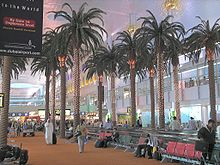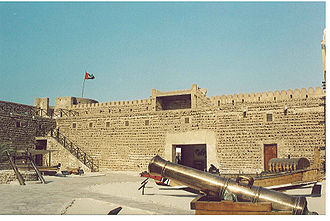- Tourism in Dubai
-

Life in the UAECuisine
Culture
Communications
Cinema
Demography
Education
Geography
Human rights
Military
Media
Politics
Music
Transport
Religion
Sport
Tourismedit box Tourism in Dubai is an important part of the Dubai government's strategy to maintain the flow of foreign cash into the emirate. Dubai's lure for tourists is based mainly on shopping, but also on its possession of other ancient and modern attractions.
Dubai is the most populous emirate of the seven emirates of United Arab Emirates. It is distinct from other members of the UAE in that revenues from petroleum and natural gas account for only 6% of its gross domestic product. A majority of the emirate's revenues are from the Jebel Ali Free Zone (JAFZ) [1] and now, increasingly, from tourism.
Contents
Transportation connections
Most capitals and other major cities have direct flights to Dubai. More than 120 airlines operate to and from Dubai International Airport to more than 260 destinations, making it one of the world's busiest. Dubai is also the home base of Emirates Airline, international airline of the UAE, which operates scheduled services to more than 100 destinations.
In June 2009 Emirates airline designated a special handling area at departures and arrivals for passengers with special needs. As a result, wheelchair passengers will receive a more personalized service.[2]
Entry regulations
Most travelers need to obtain a Visit Visa prior to entering Dubai. However, citizens (and some residents) of Cooperation Council for the Arab States of the Persian Gulf (GCC) and citizens of a number of states in Europe and elsewhere (including Australia and New Zealand) can get an entry permit stamped in their passport upon arrival, good for up to 90 days. Visitors from other nationalities require the sponsorship of any U.A.E. resident or any company or hotel licensed to operate within the U.A.E. and are limited to a 30-day stay. Citizens of the UK, France, Italy, Germany, the Netherlands, Belgium, Luxembourg, Switzerland, Austria, Sweden, Norway, Denmark, Portugal, Ireland, Greece, Cyprus, Finland, Malta, Spain, Monaco, Vatican, USA, Iceland, Andorra, San Marino, Liechtenstein, Hungary, Australia, New Zealand, Japan, Brunei, Singapore, Malaysia and Hong Kong may stay for up to 30 days without a visa. [3] As of 2 January 2011, Canadian citizens must acquire a visa prior to travelling to the United Arab Emirates. Detailed information on requirements can be obtained from the wesite: uae-embassy.com. Tourists can get a visa from a tourist company or a hotel by first making a reservation for at least one night. They must fax/courier the hotel a copy of their passport along with the reason for the visit (tourism is an acceptable reason) and their arrival date. You must also make sure that the hotel faxes you a copy of the visa when it is ready. Airlines may require confirmation (preferably a fax copy of the document) that a visa is held before check-in at the airport. The original is held at Dubai Airport for collection before passport control.[4]
Dubai Visa Rules Changed in 2010:
Since 2010 there has been another change to visa rules in Dubai. The countries that have to apply for visa in advance they will have to apply the normal ways they do. The only thing that has changed for business travellers & Tourist if you leave the UAE – you must stay out of the country for 30 days then apply for new visa again.
For western countries who get the visa at the airport, the first visa is free but if you want a second visa for another 30 days you have to pay a fee of 600AED (around 170-190USD) at the local immigration department in Dubai.
Behaviour and dress restrictions
Dubai enforces many strict behavioral rules that occasionally get western visitors into trouble. Homosexuality is illegal, even kissing in public is illegal. Dancing is only allowed in hotels or a licensed nightclub, public dancing is also considered illegal. In April 2010, two British holidaymakers were jailed for a month after a local woman took objection to them kissing each other on the cheek as a greeting in a restaurant.[5]
Additionally, visitors are also required to obey Muslim religious restrictions even if they are not Muslim themselves; such as eating or drinking in public places in the daytime during Ramadan fasting or consuming alcohol anywhere besides some licensed venues. In 2008 a Russian woman was put on trial for drinking juice in public during the month of Ramadan.[6]
Wearing a bikini, swimming suit or swimming trunks are only permitted on certain beaches, and it is illegal to go topless or wear a thong. Wearing swimsuits away from the beach may get you arrested under public decency laws. Women are usually advised not to wear mini skirts or shoulderless tops.
Legal Dangers and Drug Traffic
Travellers entering Dubai can be jailed for 4 years or more if found in possession (including in the bloodstream and the bottom of the shoes[7]) of illegal drugs(even in quantities as small as 0.001g), including medicines such as codeine.[8][9] A senior Dubai judge was quoted on February 11, 2008, by the Dubai City News saying, "These laws help discourage anyone from carrying or using drugs. Even if the amount of illegal drugs found on someone is 0.05 grams, they will be found guilty. The penalty is a minimum four years. The message is clear — drugs will not be tolerated."[8] A number of travellers have been held pending charge while Dubai authorities test their possessions, blood and urine for any trace of contraband.[10]
Health
No special immunizations are required but tourists are encouraged to purchase appropriate medical insurance before travelling. Government immunization programs has led to recognition by a travel magazine.[2] As a latest addition to the established modern health care system, Dubai is offering online health care contacts of virtually all medical doctors in Dubai.[11]
Shopping tourism
Dubai has been called the "shopping capital of the Middle East."[12] The city draws large numbers of shopping tourists from countries within the region and from as far as Eastern Europe, Africa and the Indian Subcontinent. Dubai is known for its souk districts. Souk is the Arabic word for market or place where any kind of goods are brought or exchanged. Traditionally, dhows from the Far East, China, Sri Lanka, and India would discharge their cargos and the goods would be bargained over in the souks adjacent to the docks.[13] Dubai's most atmospheric shopping is to be found in the souks, located on either side of the creek, where bargaining is part of the buzz.
Modern shopping malls and boutiques are also found in the city. Dubai Duty Free at Dubai International Airport offers merchandise catering to the multinational passengers using Dubai International Airport.
While boutiques, some electronics shops, department stores and supermarkets may operate on a fixed-price basis, most other outlets consider friendly negotiation as a way of life.
Dubai's numerous shopping centres cater for every consumer’s need. Cars, clothing, jewellery, electronics, furnishing, sporting equipment and any other goods will all be likely to be under the same roof.[14]
Dubai Shopping Festival
Main article: Dubai Shopping FestivalThe Dubai Shopping festival is a month-long festival held during month of January each year. During the festival the entire emirate becomes one massive shopping mall. Additionally, the festival brings together music shows, art exhibitions, and folk dances.[15]
Cultural tourism
Sightseeing usually comes second for most visitors, who visit the city for shopping and entertainment.
Aspects of Dubai's old culture, while occasionally overshadowed by the boom in economic development, can be found by visiting places around the creek, which splits Dubai into two halves, Bur Dubai and Deira. The buildings lining the Bur Dubai side of the Creek provides the main flavor of the old city. Heritage Village offers a simulacrum of old Dubai. The adjoining Diving Village offers exhibits on pearl diving and fishing. The Diving Village forms part of an ambitious plan to turn the entire "Shindagha" area into a cultural city, recreating life in Dubai as it was in days gone by.
Other attractions include the Sheikh Saeed Al Maktoum House; the Dubai Museum in the restored Al Fahidi Fort, which was erected around 1799; and the Heritage Village of Hatta, situated 115 kilometers southeast of Dubai City in the heart of the rocky Hatta Mountains. The history of the village can be traced back 2000 – 3000 years. It consists of 30 buildings, each differing in size, interior layout and building materials used. Great care was taken to use the same materials as those used when originally built during the renovation such as mud, hay, sandalwood and palm fronds. The Sharia Mosque is an old mosque built around 200 years ago using the same building materials and consists of a large prayer hall, a court and courtyard, minaret and other utility rooms.[16]
Tourist accommodation in Dubai is plentiful and relatively expensive with all the major chains having a presence. One increasingly popular alternative is for visitors to rent apartments and villas on a short term basis.[17]
See also
- United Arab Emirates
- Burj Al Arab
- Burj Khalifa
- Dubai Zoo
- List of tourist attractions in Dubai
- Developments in Dubai
- List of development projects in Dubai
- Dubai Festival City
- Dubai International Airport
- Dubai Waterfront
- List of hotels in Dubai
- List of shopping malls in Dubai
- Dubai Museum
- Palm Islands
- The World
- Bawadi
References
- ^ Dubai Trade
- ^ a b Dubai Travel Tips
- ^ http://uae-embassy.org/html/Consulate/General_Info.html
- ^ Dubai Visa Requirements
- ^ Spencer, Richard; Laing, Aislinn (2010-03-14), "Britons sentenced to a month in prison for kissing in Dubai restaurant", The Daily Telegraph, http://www.telegraph.co.uk/news/worldnews/middleeast/dubai/7443079/Britons-sentenced-to-a-month-in-prison-for-kissing-in-Dubai-restaurant.html, retrieved 2010-04-08
- ^ "Russian woman put on trial in Dubai for drinking juice in public", Pravda, 23/09/2008, http://english.pravda.ru/society/stories/23-09-2008/106429-dubai-0
- ^ Daily Mail: Briton jailed for four years in Dubai after customs find cannabis weighing less than a grain of sugar under his shoe
- ^ a b Paul McLennan and Ali Al-Shouk (2008-02-11). "Tourists get drug warning". Dubai City News. http://www.7days.ae/en/2008/02/11/tourists-get-drug-warning.html. Retrieved 2008-02-12.
- ^ "Tourists face jail". Dubai City Magazine. 2008-02-08. http://www.dubaicitymagazine.com/2008/02/08/tourists-facing-dubai-jail/. Retrieved 2008-02-12.
- ^ "Charity issues urgent warning to all travellers to UAE after Briton is imprisoned for 4 years". Fair Trials International. 2008-02-07. http://www.fairtrials.net/index.php/news/article/charity_issues_urgent_warning_to_all_travellers_to_uae_after_briton_impriso/. Retrieved 2008-02-12.
- ^ Gulf News
- ^ Shopping in dubai
- ^ Souq - DataDubai
- ^ Dubai shopping centres
- ^ MyDSF
- ^ Destinations Dubai
- ^ Dubai Villas
 United Arab Emirates topics
United Arab Emirates topicsHistory Politics Emirates · Federal National Council · Military of the United Arab Emirates · President · Prime Minister · Rulers · Elections · 2006 election · Foreign relations · Military · Foreign Aid · Law · Human Rights · LGBT rights · Hizb ut-TahrirGeography Cities · Towns and Villages · Climate · Resources and land use · Environmental concerns · Land DisputesEconomy Demographics List of United Arab Emiratis (Emirati people) · Language · Education · Religion · Health · Human rights · Women · Sunni Muslim · Shi'a MuslimCulture Transport Highways · Railways · Ports and Harbors · Airlines · Water TransportCommunication Radio and Television · Telecommunication Companies · Media · Telecommunications Regulatory Authority · Internet domainTourism Hotels in the United Arab Emirates · Visitor Attractions · Resorts in the United Arab Emirates · CrimeSymbols Topics · Portal Categories:
Wikimedia Foundation. 2010.


